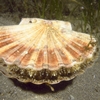Other Names
- Port Lincoln Oyster
- Southern Flat Oyster
- Stewart Island Oyster
- Tasmanian Flat Oyster
General Description
These large shells are rounded with the left valve somewhat concave and the right quite flat. Valve surfaces have a flaky, layered (lamellose) appearance, and crumble easily (friable). Valve margins are undulating. Shell up to 18 cm across.
Biology
This species is closely related to the European Edible Oyster and was harvested extensively in the early years of European settlement until the population crashed during the nineteenth century. It was also a food source for indigenous communities. Today, it is no longer found in seafood markets.
Habitat
Bays and inlets, in mud, from low tide to depth of 30 m.
Soft substrates
Distribution guide
Southern Australia.
Species Group
Sea snails and shells › Bivalves
Depth
Shore (0-1 m)
Shallow (1-30 m)
Water Column
Max Size
18 cm
Diet
Organic matter
Commercial Species
Yes
Global Dispersal
Recorded in Australia
Species Code
MoV 1557
Conservation Status
- DSE Advisory List : Not listed
- EPBC Act 1999 : Not listed
- IUCN Red List : Not listed







